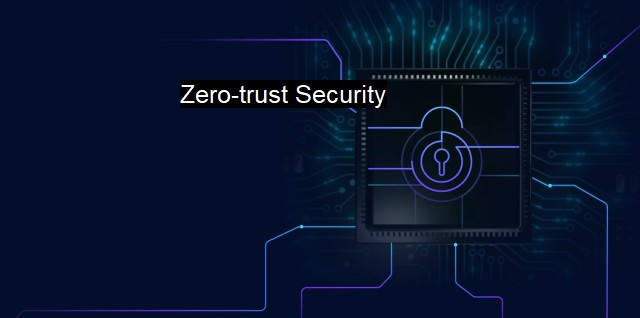What is Zero-trust Security?
Revolutionizing Cybersecurity: The Benefits and Implementation of Zero-Trust Security Models
Zero-trust security, as the name suggests, operates on the principle of maintaining stringent access controls and not trusting anything inside or outside its perimeters by default. In the context of cybersecurity and antivirus applications, it is a highly effective approach towards ensuring optimum security conditions. It is a concept that requires the verification of every individual and device attempting to gain access to its resources, thereby lessening the possibility of an unauthorized breach.In traditional IT infrastructure, security measures primarily focused on safeguarding the perimeters to enable smooth operations inside. The thinking behind this was, if anything is already inside the security perimeter, it could be trusted. recent developments and increasing security threats have led the industry to rethink this approach. Issues like data breaches and ransomware attacks have been primarily due to this obsolete security model. Hence, the necessity for a new way of thinking emerged giving birth to the concept of zero-trust security.
Zero-trust security operates on the premise that trust is a vulnerability and that no user or device should be trusted by default. Instead, it requires verification at every step from every user, irrespective of their location. It does not differentiate between external or internal threats. All individuals and devices are considered potentially dangerous and treated as external entities seeking access, hence enforcing stringent entry checks.
Autonomous devices and digital users have escalated multifariously. This has necessitated the enactment of stricter and more effective security measures. One cannot just rely on firewalls and Virtual Private Networks (VPNs) and be rest assured of no cybersecurity threats. Identifying and dealing with the identified threats is crucial. equally important is pre-empting and preparing for unknown cyber threats and vulnerabilities. Zero-trust security assists with the same by making every user and device pass through sophisticated processing modules assessing their credibility as well as threat level before gaining access.
Zero-trust security devises controls and monitors individual sessions based on users' behaviors and activities. This enhanced visibility and control ensure early detection and blocking of suspicious activities in real-time. Powered with advanced security features like multi-factor authentication, encryption, orchestration, and scoring security vendors enhance their zero-trust network frameworks.
It might appear initially that the constant need for verification may lead to performance issues and might be unpopular among the users. as per the definition, in zero-trust security it is not a question of trust but a question of maintaining rigid security standards. Through this design, it ensures not to inflict limitations on the secure, verified, and authorized usage.
The scope of the model of zero-trust security is quite vast. It caters to network security, data security, endpoint security, identity verification, asset discovery and classification, application security, etc. signify the holistic and thorough nature of zero-trust frameworks. Irrespective of the size and nature of the company, it can benefit immensely through zero-trust implementation.
For optimum results from zero-trust security, it is necessary to have a strategic rollout. Training and creating awareness among all the users should hold a primary position in every institution's zero trust journey seeking to instill and promote the motto of "never trust, always verify." This measure protects the critical data and information of the organization, leading to enhanced trust among clients, vendors, and other stakeholders.
The necessity for zero-trust security is now strongly established due to the mounting cyber threats. It's a move away from conventional trust-based settings. Although resources are required for transitioning to this form of security, the long-term pay-off in reducing the attack surface and enhancing overall security renders it worthwhile. Despite the common phrase, 'In God we trust,' proving to be a strong hold in many respective fields, it is clear that cybersecurity isn't one of these fields, thereby needing the operation of a zero-trust model.

Zero-trust Security FAQs
What is zero-trust security?
Zero-trust security is a cybersecurity approach that assumes all devices, users, and applications are potentially compromised and must be verified and authorized before being granted access to a network or resource. It is based on the principle of "never trust, always verify."Why do we need zero-trust security?
We need zero-trust security because traditional security models that rely on perimeter defenses and trust-based authentication are no longer effective against modern cyber threats. Zero-trust security provides a more robust and flexible security framework that can adapt to today's dynamic and distributed digital environments.What are some key components of zero-trust security?
Some key components of zero-trust security include multi-factor authentication, continuous monitoring, network segmentation, micro-segmentation, and access controls based on user behavior and context. These measures help minimize the attack surface and reduce the risk of unauthorized access or data breaches.How can organizations implement zero-trust security?
Organizations can implement zero-trust security by taking a phased approach that involves assessing their current security posture, identifying high-value assets and risks, defining access policies, and implementing appropriate technologies and controls. This may involve adopting cloud-based security solutions, integrating security tools and platforms, and training employees on best practices for maintaining a zero-trust posture.| | A | | | B | | | C | | | D | | | E | | | F | | | G | | | H | | | I | | | J | | | K | | | L | | | M | |
| | N | | | O | | | P | | | Q | | | R | | | S | | | T | | | U | | | V | | | W | | | X | | | Y | | | Z | |
| | 1 | | | 2 | | | 3 | | | 4 | | | 7 | | | 8 | | |||||||